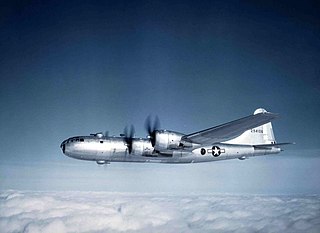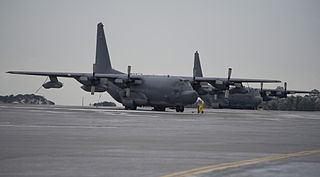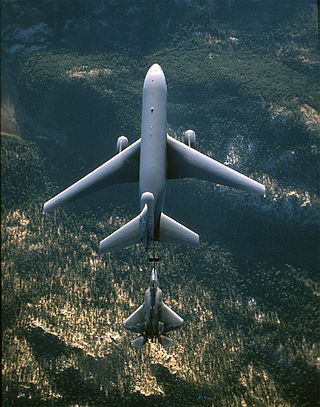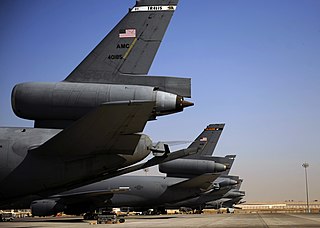
The 22nd Operations Group is the operational flying component of the United States Air Force 22nd Air Refueling Wing. It is stationed at McConnell Air Force Base, Kansas, and is part of Air Mobility Command (AMC)'s Eighteenth Air Force.

The 468th Bombardment Group was a World War II United States Army Air Forces combat organization. The unit served primarily in the Pacific Ocean theater and China Burma India Theater of World War II as part of Twentieth Air Force. The 468th Bomb Group's aircraft engaged in very heavy bombardment Boeing B-29 Superfortress operations against Japan. After its reassignment to the Mariana Islands in 1945, its aircraft were identified by a "I" and a triangle painted on the tail. It was inactivated on 31 March 1946.

The 504th Bombardment Group was a World War II United States Army Air Forces combat organization.

The 29th Flying Training Wing is an inactive United States Air Force unit last based at Craig Air Force Base, Alabama. It was inactivated when Craig was closed when the Air Force reduced its pilot training program after the Vietnam War.

The 383d Bombardment Group is a former United States Army Air Forces unit. It was last stationed at Camp Anza, California, where it was inactivated on 4 January 1946. The group was active from 1942 to 1944 as a heavy bomber training unit. It was reorganized as a very heavy bomber unit and trained for deployment overseas. However, it arrived at its overseas station too late to see combat, and returned to the United States, where it was inactivated.

The 93rd Bomb Squadron, sometimes written as 93d Bomb Squadron, is a squadron of the United States Air Force Reserve. It is assigned to the 307th Operations Group of Air Force Reserve Command, stationed at Barksdale Air Force Base, Louisiana. The squadron is equipped with the Boeing B-52H Stratofortress, and is the Air Force's B-52 Formal Training Unit (F.T.U.).

The 19th Special Operations Squadron is an Air Force Special Operations Command unit, part of the 492nd Special Operations Wing at Hurlburt Field, Florida. It conducts crew training for AC-130 and Lockheed MC-130 aircraft.

The 6th Air Refueling Squadron is part of the 60th Air Mobility Wing at Travis Air Force Base, California. It operates the McDonnell Douglas KC-10 Extender aircraft conducting mobility, and air refueling missions.

The 2d Bombardment Squadron is an inactive United States Air Force unit. Its last assignment as a Boeing B-52 Stratofortress squadron was with the Strategic Air Command 22d Bombardment Wing stationed at March Air Force Base, California. It was inactivated on 1 October 1982. The unit was redesignated as the 2d Strategic Squadron as a Boeing KC-135 Stratotanker rotational squadron with the 306th Strategic Wing and was last active at RAF Mildenhall, England in 1992.

The 22d Expeditionary Air Refueling Squadron is a provisional United States Air Force unit, assigned to Air Mobility Command. It is engaged in combat operations as part of the Global War on Terrorism in Afghanistan. Its current status and location are undetermined. The squadron's permanent designation is the 22d Air Refueling Squadron.

The 64th Bombardment Squadron is an inactive United States Air Force unit that was last assigned to the 43rd Bombardment Wing at Little Rock Air Force Base, Arkansas, where it was inactivated on 31 January 1970.

The 435th Bombardment Squadron, also known as the "Kangaroo" Squadron, is an inactive United States Air Force unit. It was last assigned to the Eighth Air Force 333d Bombardment Group, based at Kadena Air Base, Okinawa. It was inactivated on 28 May 1946.

The 44th Reconnaissance Squadron is a unit of the United States Air Force's 432nd Wing, Air Combat Command and stationed at Creech Air Force Base, Nevada, where it operates unmanned aerial vehicles. The squadron is assigned to the 432nd Operations Group, and has been reported to operate the Lockheed Martin RQ-170 Sentinel.

The 44th Bombardment Squadron is an inactive United States Air Force unit. Its last assignment was with the 40th Bombardment Wing, based at Forbes Air Force Base, Kansas. It was inactivated on 1 September 1964.

The 371st Bombardment Squadron is an inactive United States Air Force unit. Its last assignment was with the 307th Bombardment Wing, based at Lincoln AFB, Nebraska. It was inactivated on 25 March 1965.

The 98th Air Refueling Squadron is an inactive United States Air Force unit. Its last assignment was with the 92d Operations Group at Fairchild Air Force Base, Washington, where it was inactivated on 1 July 1998.

The 788th Tactical Fighter Squadron is an inactive United States Air Force unit. During World War II, as the 788th Bombardment Squadron, it was assigned to the 467th Bombardment Group as a Consolidated B-24 Liberator squadron in 1943. After training in the United States, it moved to the European Theater of Operations the following year. It saw combat until the surrender of Germany in May 1945, earning a French Croix de Guerre with Palm for its actions contributing to the liberation of France. From May to August 1944, the squadron was detached to the 801st Bombardment Group (Provisional) engaging in Operation Carpetbagger operations. After V-E Day, the squadron returned to the United States and transitioned into the Boeing B-29 Superfortress It was inactivated on 4 August 1946 at Clovis Army Air Field, New Mexico.

The 908th Expeditionary Air Refueling Squadron is a provisional United States Air Force (USAF) unit. It is assigned to the 378th Air Expeditionary Wing at Prince Sultan Air Base in Saudi Arabia. It has supported combat operations in Afghanistan, Iraq, and Syria from its previous location of Al Dhafra Air Base in the United Arab Emirates. The squadron has a varied background, having been formed by a series of consolidations of no fewer than five distinct units.

The 7th Bombardment Squadron is an inactive United States Air Force unit. It was last assigned to the 34th Bombardment Group at Sioux Falls Army Air Field, South Dakota, where it was inactivated on 28 August 1945.

The 330th Aircraft Sustainment Group was a group of the United States Air Force stationed at Robins Air Force Base, Georgia. It was last active in June 2010
























